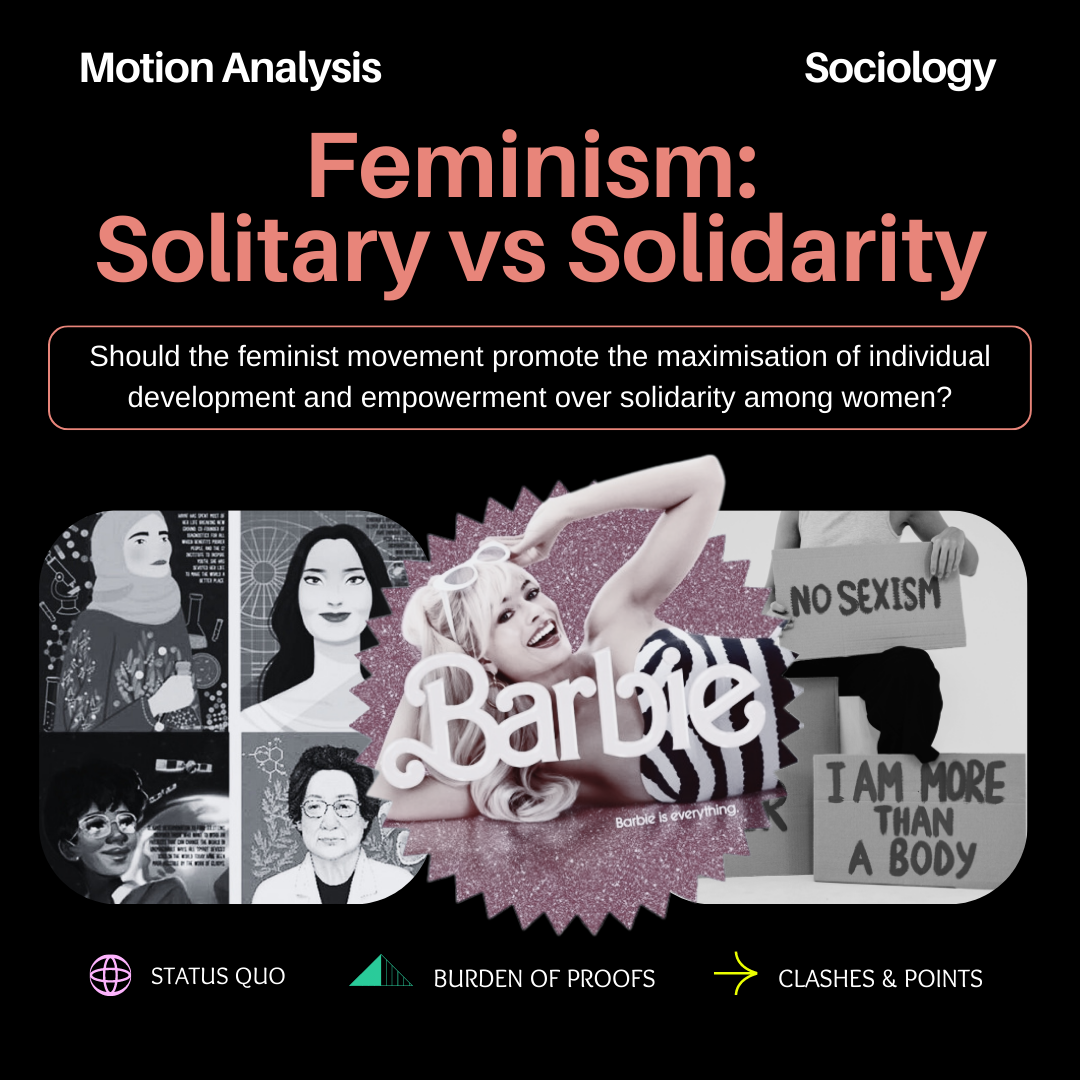Feminism
Feminism is a movement born from the need to promote the intellectual equality of the genders to battle the patriarchy and to support the growth of womankind.
For those of you who've just watched Barbie, this debate may answer the questions provoked by the movie’s comedy-centric portrayal of real-world ideologies. From the film, an idea that is placed by Greta Gerwig among many is that you shouldn’t (as a woman) put other women down to achieve your own goals.
But is the success of the feminist movement actually better served by the individual success of each woman or the collective success of women? With some of our own argumentation, let us give you the perspectives based on this analysis of the 4th Round of WSDC 2023 where Team Malaysia as Proposition and Team Sri Lanka as Opposition debate the motion:
This house believes that the feminist movement should promote the maximisation of individual development and empowerment over solidarity among women.
Goodluck making a decision! Let us know if you take the side of solitary or solidarity.
Status Quo: The Uprising of Choice Feminism
It's important to understand that both sides would agree that the feminist movement seeks to achieve rights for women, in any way possible – no question on whether feminism really helps womankind as a whole.
Choice feminism, however, is motivated by a fear of politics. It arises in response to three common criticisms of feminism: that feminism is too radical, too exclusionary, and too judgmental. In response, choice feminism offers a worldview that does not challenge the status quo, that promises to include all women regardless of their choices, and that abstains from judgment altogether. Choice feminism is the belief that the individual choices of a woman are inherently feminist. According to choice feminism, a stay-at-home mother and a business woman are equally feminist, because they both have exercised the right of choice and therefore expressed their individual freedom. There comes the question of whether choice feminism will be inherently good for the movement.
This underscores some already existing barriers to achieving the best for the feminist movement and understanding what is best for feminism, moving forward. So the debate then becomes about what strategies should be supported to best alleviate existing barriers in the status quo & incentivise actions that support the ultimate ideal of the movement – achieving gender equality.
Proponents of solitary would argue that in the status quo, the feminist movement has already achieved its ideals for equal rights (eg: voting, and job opportunities) and that the battle against current forms of oppression against women varies according to their communities. The fight for feminism then becomes an individualised journey, no longer the collective oppression against women that existed before.
Opponents of solitary, in addition to supporting solidarity, believe otherwise in the state of feminism, today. They argue that a large majority of women, especially in developing countries, have not achieved basic feminist rights. Different women from different backgrounds do still face similar root causes i.e. stereotypes that stem from patriarchy, hence the need for solidarity.
#1 Diversity in the Feminism Landscape
Proponents believe that the maximisation of individual empowerment deals with diversity in the feminism landscape. In a world where patriarchal oppression is no longer universal, where oppression is individualised, the evolution of social expectations demands pursuing individual empowerment.
They argue that solidarity extends women’s oppression, in which the collective movement will try to homogenise what is best for all women and thus limits choice feminism. The pathway towards empowerment spearheaded by the feminism movement will also be steered in a biased direction, whereby the advocation and institution of policies will be dominated by women from the higher echelon (Caucasian, rich women), resulting in the creation of policies that might come at the expense of other women or even enforce some form of race supremacy. Solidarity also contributes to the demonisation of women who do not fit into the collective norms such as attaining wealth and status using unconventional means (OnlyFans creators, etc.).
The focus towards individual empowerment ensures that at the very least, some women can get into positions of power regardless of the avenues they take and advocate for empowerment for the feminism movement. Women are also less likely to be shamed for things like accepting job promotions, getting a pay raise since resources in society are zero-sum with the possibility of causing some other women to inevitably lose out. Consequently, the ascension to power allows more inclusivity for traditionally patriarchal terms to include women as well, such as acknowledging women as leaders too.
Opponents however suggest individuality comes at the cost of doing whatever it takes to succeed as a woman in a certain field, even if it means putting other women down. Extreme polarity in women’s status coupled with no incentives for women in power to contribute back to the feminist movement may become counter-productive for the movement.
They argue that solidarity promotes community building and having a shared identity as feminists will more likely increase the retention rate of women within the movement. Even at the proposition's best, encouraging diverse participation of empowered women is not exclusive to Proposition alone. By glorifying the very act of being in the movement and giving back to the movement, it increases the likelihood of women participating in advocacy compared to the proponents’ ideals of requiring women to be individually successful to be considered as part of the movement. They also argue that the emphasis on individual empowerment demotivates women to engage in collective actions such as protesting or pushing for affirmative action as it comes at a high individual cost.
The solitary approach to individual empowerment will very likely place highly privileged women as the face of the feminist movement and dictate policies that might not necessarily safeguard the interests of marginalised women. Not to mention, the journey towards success is an extremely difficult journey and the act of solitary dissolves the interaction between women because they view each other as competitors instead of allies, thus vanishing the feeling of community within the movement.
#2 Progress in the Feminism Movement
Proposition suggest that the rate of progress is higher compared to opposition, whereby the quantitative success of women in society serves as a testament that the movement is progressing with more women in positions of power. This creates a path for women to advocate for empowerment that would not be hindered by the notion of needing to prioritise community contributions first.
Individual empowerment which encompasses self-actualisation regardless of how they want to achieve it can better unite disparate groups of women from different backgrounds and communities. Proposition suggests that prioritising all women’s suffering better illustrates the intersectionality of the movement compared to opposition’s approach of necessitating women to think about other women before themselves.
Opposition on the other hand points out the fact that proposition might not even be able to achieve the rate of progress they harped about in light of the fact that women in power might not feel the need to recontribute back to the feminist movement. Those women might have already subconsciously bought into patriarchal norms when rising into power, and this phenomenon is exacerbated even further when they have limited interaction and support from other women.
On the flipside, opposition finds that solidarity provides a better avenue for the feminist movement to achieve its objective of uplifting women. The community safespace formed as a result of a singular identity as women creates a stronger safety net for women in case they are unable to attain success. They are less likely to be alienated for not fulfilling the threshold of being a successful women, but rather applauded and supported for the very effort these women have put in.
#3 Narrative within the Feminism Movement
Proposition suggests that solidarity necessitates the selfless and self-sacrificing perspective which limits the heights that can be achieved by women. They propose that the narrative they portray would be able to promote better inclusivity for all women and prioritise all sufferings by different women and their successes despite that. They do not enforce the liberal form of feminism (i.e. wearing revealing clothing, not wearing a hijab) forcefully onto women as propagated on side opposition by women from the higher echelon.
Proposition stresses on the fact that there is no universal solution to the problems faced by women as a whole. They strengthen the narrative of giving individualised help and support to women who need it, simultaneously respecting their decisions of self-actualisation be it being a housewife or a stay-at-home mother, eradicating the stereotypical girlboss culture that is prevalent in society.
Opposition argues solidarity allows more internal control of the narrative within the feminist movement with less domination by women from the higher echelon. This can create better assurance of the value of every woman's participation in the movement regardless of individual achievements. Consequently, opposition allows better accessibility for women to the movement and therefore expands the reach of their advocacy.
Opposition also suggests the fact that with the solitary approach towards individual success, it will be easier for anti-feminists to manipulate the narrative within the movement due to the weak spot created by the lack of interaction and communication between competing women. The feminist movement will be further divided due to anti-feminist propaganda and causes cross-collaboration between different feminist groups to become increasingly difficult with the dissent in common interests.
Burden of Proofs
Having understood the extent of arguments from both ends, there comes the question of whether each side has given substantial answers to some key questions demanded by the motion. It's your turn to evaluate!
Proponents should proof that individual development allows the development of the feminism movement due to higher status gained by women.
Opponents should proof that solidarity encourages women to be a part of the feminism movement and contribute back to the movement.
What is better for feminism? Spearheaded movement by distinct successful women or by the control of a collective narrative that puts value in everyone's participation?
Wow, that's a whole lot to consider!
Here's a document that summarises all you need to know about understanding both ends of the topic at hand.
You may use this for mock debates, or just to develop an understanding of feminism and the crossroad the movement is facing!
Additionally, here are some valuable resources to read into if you're interested in diving deeper into the arguments brought forth!
- https://magdalene.co/story/choice-feminism-and-why-its-not-enough/ on the question of whether choice feminism is the way to go
- https://www.thoughtco.com/what-is-feminism-3528958 on the types of feminism that exist in society
And lastly, credits to Team Malaysia & Team Sri Lanka of WSDC 2023 for the insightful session!

